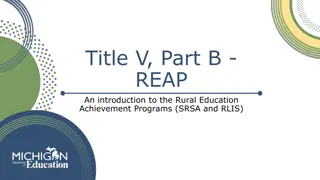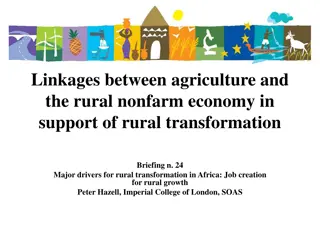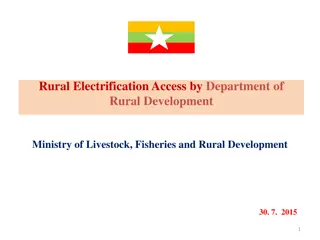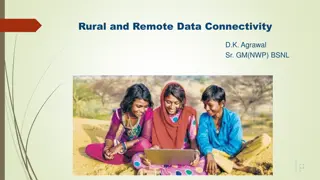Rural Marketing Insights - Opportunities and Challenges
The concept of rural marketing in India reveals the untapped potential and evolving trends in reaching the vast rural consumer base. Explore the significance, features, and present scenario of rural marketing, along with the emerging opportunities and challenges. Discover the unique dynamics of rural markets and the evolving consumer behaviors reshaping the marketing landscape.
Download Presentation

Please find below an Image/Link to download the presentation.
The content on the website is provided AS IS for your information and personal use only. It may not be sold, licensed, or shared on other websites without obtaining consent from the author.If you encounter any issues during the download, it is possible that the publisher has removed the file from their server.
You are allowed to download the files provided on this website for personal or commercial use, subject to the condition that they are used lawfully. All files are the property of their respective owners.
The content on the website is provided AS IS for your information and personal use only. It may not be sold, licensed, or shared on other websites without obtaining consent from the author.
E N D
Presentation Transcript
Introduction Concept of Rural Marketing Definition Features of Rural Marketing Importance of Rural Marketing Present Scenario of Rural Marketing Opportunities & Challenges in Rural Marketing
The emergence of rural markets as highly untapped potential emphasizes the need to explore them. Marketers over the past few decades, with innovative approaches, have attempted to understand and tap rural markets. Some of their efforts paid off and many markets still an enigma. Rural marketing is an evolving concept, and as a part of any economy, has untapped potential; marketers have realized the opportunity recently. Improvement in infrastructure and reach, promise a bright future for those intending to go rural. Rural consumers are keen on branded goods nowadays, so the market size for products and services seems to have burgeoned. urbanization in terms of exposure, habits, lifestyles, and lastly, consumption patterns of goods and services. So, there are dangers on concentrating more on the rural customers. Reducing the product features in order to lower prices is a dangerous game to play. Rural buyers like to follow the urban pattern of living. Astonishingly, as per the census report 2003-04, there are total 638365 villages in India in which nearly 70% of total population resides; out of them 35 % villages have more than 1000 population. The rural population has shown a trend of moving to a state of gradual expenditure grew by 9.6 per cent. There is a tremendous potential for consumer durables like two-wheelers, small cars, television sets, refrigerators, air-conditioners and household appliances in rural India. Rural per capita consumption expenditure grew by 11.5 per cent while the urban
Concepts of Rural Marketing The concept of Rural Marketing in India Economy has always played an influential role in the lives of people. In India, leaving out a few metropolitan cities, all the districts and industrial townships are connected with rural markets. The rural market in India generates bigger revenues in the country as the rural regions comprise of the maximum consumers in this country. The rural market in Indian economy generates almost more than half of the country s income. Rural marketing in Indian economy can be classified under two broad categories. These are: i. The market for consumer goods that comprise of both durable and non-durable goods ii. The market for agricultural inputs that include fertilizers, pesticides, seeds, and so on the mind of people who think rural marketing is all about agricultural marketing. However, rural marketing determines the carrying out of business activities bringing in the flow of goods from urban sectors to the rural regions of the country as well as the marketing of various products manufactured by the non-agricultural workers from rural to urban areas. The concept of rural marketing in India is often been found to forms ambiguity in
Definition Rural marketing is similar to simply marketing. Rural marketing differs only in terms of buyers. Here, target market consists of customers living in rural areas. Thus, rural marketing is an application of marketing fundamentals (concepts, principles, processes, theories, etc.) to rural markets. rural specific goods and services leading to desired exchange with rural customers to satisfy their needs and wants, and also to achieve organizational objectives. Rural marketing is a process of developing, pricing, promoting, and distributing equally applicable in relation to rural segments. We will add only specific word rural to define the term: Rural marketing is a process of planning, and executing the conception, pricing, promotion, and distribution of ideas, goods, and services to create exchange (for rural segments) that satisfy individual and organizational objectives. Definition of marketing stated by American Marketing Association can be
Features of Rural Marketing Rural marketing is now a two-way marketing process. There is inflow of products into rural markets for production or consumption and there is also outflow of products to urban areas. The urban to rural flow consists of agricultural inputs, fast-moving consumer goods (FMCG) such as soaps, detergents, cosmetics, textiles, and so on. The rural to urban flow consists of agricultural produce such as rice, wheat, sugar, and cotton. There is also a movement of rural products within rural areas for consumption. The main reason why the companies are focusing on rural market and developing effective strategies is to tap the market potential, that can be identified as follows: Large and scattered population Higher purchasing capacity Market growth Development of infrastructure Low standard of living Traditional outlook Marketing mix
1. Large and scattered population: According to the 2001 census, 740 million Indians forming 70 per cent of India s population live in rural areas. The rate of increase in rural population is also greater than that of urban population. The rural population is scattered in over 6 lakhs villages. The rural population is highly scattered, but holds a big promise for the marketers. 2. Higher purchasing capacity: Purchasing power of the rural people is on rise. Marketers have realized the potential of rural markets, and thus are expanding their operations in rural India. In recent years, rural markets have acquired significance in countries like China and India, as the overall growth of the economy has resulted into substantial increase in purchasing power of rural communities. 3. Market growth: The rural market is growing steadily over the years. Demand for traditional products such as bicycles, mopeds and agricultural inputs; branded products such as toothpaste, tea, soaps and other FMCGs; and consumer durables such as refrigerators, TV and washing machines has also grown over the years. 4. Development of infrastructure: There is development of infrastructure facilities such as construction of roads and transportation, communication network, rural electrification and public service projects in rural India, which has increased the scope of rural marketing.
5. Low standard of living: The standard of living of rural areas is low and rural consumers have diverse socio-economic backwardness. This is different in different parts of the country. A consumer in a village area has a low standard of living because of low literacy, low per capita income, social backwardness and low savings. 6. Traditional outlook: The rural consumer values old customs and traditions. They do not prefer changes. Gradually, the rural population is changing its demand pattern, and there is demand for branded products in villages. 7. Marketing mix: The urban products cannot be dumped on rural population; separate sets of products are designed for rural consumers to suit the rural demands. The marketing mix elements are to be adjusted according to the requirements of the rural consumers.
Importance of Rural Marketing Rural marketing implies applying marketing theory and directing marketing efforts to create and satisfy needs and wants of rural market (customers). Importance of marketing indicates the contribution of rural as well urban marketing. Following are the importance of Rural Marketing: Reduced Burden on Urban Population Rapid Economic Growth Employment Generation Improved Living Standard Development of Agro Optimum Utilization of Rural Untapped Resources Easy Marketability of Agricultural Produces Improved Rural Infrastructures Price Stability Quality of Life and Reduced Crime Balanced Industrial Growth
1. Reduced Burden on Urban Population: Rural marketing can contribute to rural infrastructure and prosperity. People can also live comfortably in villages due to availability of all goods and services in villages, even comparatively at low price. People, due to growth of marketing activities, can earn their livelihood in rural places. Population pressure on urban can be reduced. 2. Rapid Economic Growth: Naturally, marketing acts as catalyst agent for economic growth. There exists more attractive business opportunities in rural than urban. Rural market is more potential for consumer durables and services. Rural population largely depends on agriculture and it can contribute nearly 50% to total national income. Agriculture enjoys significant portion in export business, too. Rural marketing improves agricultural sector and improved agricultural sector can boost whole economy of the country. 3. Employment Generation: At present, nearly 70% of total Indian population feeds on agricultural activities in rural areas. Rural marketing can generate more attractive employment opportunities to rural and urban people. Growth of rural marketing leads to increased business operations, professional activities, and services that can generate a lot of employment opportunities. 4. Improved Living Standard: Due to rural marketing system, rural buyers can easily access needed standard goods and services at fair prices. In the same way, rural marketing improves rural infrastructure. Additionally, rural marketing can also improve their income. These all aspects can directly improve living standard.
5. Development of Agro-based Industries: Rural marketing leads to set up agro-based processing industries. Fruits, vegetables, cereals, pulses, etc., are used as raw-materials. Such industries can improve farmers profit margin and employment opportunities. 6. Optimum Utilization of Rural Untapped Resources: There are unlimited businesses opportunities exist in rural areas. Untapped and underutilized resources can be utilized at optimum level and that can further accelerate overall economic growth. 7. Easy Marketability of Agricultural Produces: Growth of rural marketing improves whole marketing system. Multiple options are available to farmers and local producers to market their products. Big domestic corporate houses and multinational companies prefer to buy agricultural products directly from villages by their own or through agents and small firms. Rural producers can sell their produces easily at satisfactory prices. Their improved income level can improve their purchasing power that can further fuel to industrial demand. 8. Improved Rural Infrastructures: Rural marketing and basic infrastructures go hand to hand. Growth of rural marketing leads to improved transportation, insurance, banking, communication, entertainment, and other facilities. Due to availability of basic infrastructural facilities, business units can easily reach the target rural buyers.
9. Price Stability: Marketing results into better transportation, warehouses, and communication facilities. Agricultural products can be systematically marketed throughout the year. Huge gap between demand and supply can be avoided and, as a result, prices of most of commodities remain more or less stable. 10. Quality of Life and Reduced Crime: Marketing can refine entire living style and system. Better quality products at reasonable price, improved income level, availability of facilities, etc., have direct positive impacts on quality of life. Quality of life improves and level crime reduces. 11. Balanced Industrial Growth: The gap between rural and urban development can be reduced gradually. Rural development improves rural life and reduces pressure on urban life.
Present Scenario of Rural Marketing As we know Indian economy comprising of both urban sector as well as rural sector. And concept of rural marketing in Indian economy has always played an influential role in the lives of people. In India, leaving out a few metropolitan cities, all the districts and industrial townships are connected with rural markets. The rural market in India is not a separate entity in itself and it is highly influenced by the sociological and behavioral factors operating in the country. The Indian rural markets with its vast size and demand base offer great anveshanaindia@gmail.com, www.anveshanaindia.com 102 opportunities to marketers. About 68.84% of the consumers live in rural areas and more than half of the national income is generated from rural areas. Of the 121 Cr Indians, 83.3 Cr live in rural areas while 37.7 Cr stay in urban areas, Our nation is distributed approximately in 6,30,000 villages which can be sorted in different parameters such as literary levels, accessibility, income level, penetration, distance from nearest town etc. It is only natural that rural India occupies an important position in the marketing strategies both in the narrower and broader spectrum.
Rural marketing in Indian economy can be classified under two broad categories. These are: (a) the markets for consumer goods that comprise of both durable and non- durable goods, and (b) the markets for agricultural inputs that include fertilizers, pesticides, seeds, and so on. The concept of rural marketing in India is often been found to form ambiguity in the minds of people who think rural marketing is all about agricultural marketing. However, rural marketing determines the carrying out of business activities bringing in the flow of goods from urban sectors to the rural regions of the country as well as the marketing of various products manufactured by the non-agricultural workers from rural to urban areas
Opportunities & Challenges in Rural Marketing To gain deeper insights into the Indian rural markets and to understand the challenges and opportunities in such markets, it is necessary to analyze both internal and external conditions prevalent in the rural markets. Only after such an analysis, the challenges can be identified and appropriate strategies can be formulated. its largely untapped rural consumer base. A market with such promising potential cannot be ignored by businesses. The progressively rising income and consumption levels further add to the attraction of this market. Improving connectivity with urban area, increasing media penetration and rising literacy levels have resulted in greater product awareness, making marketing in rural India easier and more effective. The presence of fewer players in rural markets means that businesses that take the lead in establishing rural operations would face little competition in the early years. This makes it prudent to enter these markets at the earliest. Also the ever increasing focus of government on developing rural India through access to better education, better roads, greater employment opportunities, easy credit availability and so forth further enhances the future potential of the Indian Rural Market. An analysis of Indian rural markets reveals that its greatest strength lies in
But there exist some challenges and problems in the rural markets, businesses cannot ignore the risks associated with rural markets. The India rural sector has just started developing; there are insufficient infrastructural facilities, which make investments by new businesses risky. Poor media penetration and low literacy rates in rural India are significant obstacles to any marketing effort. Such conditions, coupled with rising yet still relatively low household income, sparsely located population and frequent language variations across villages make marketing India all the more difficult.























